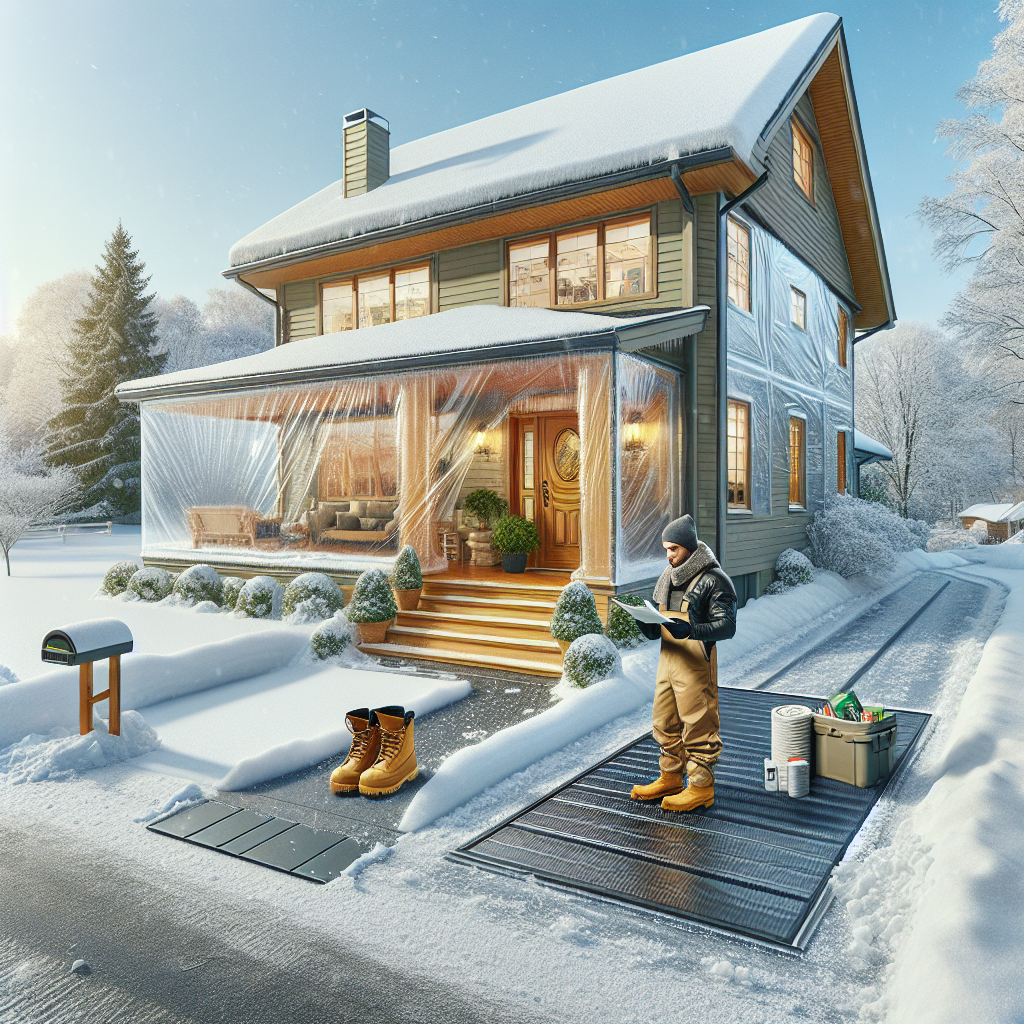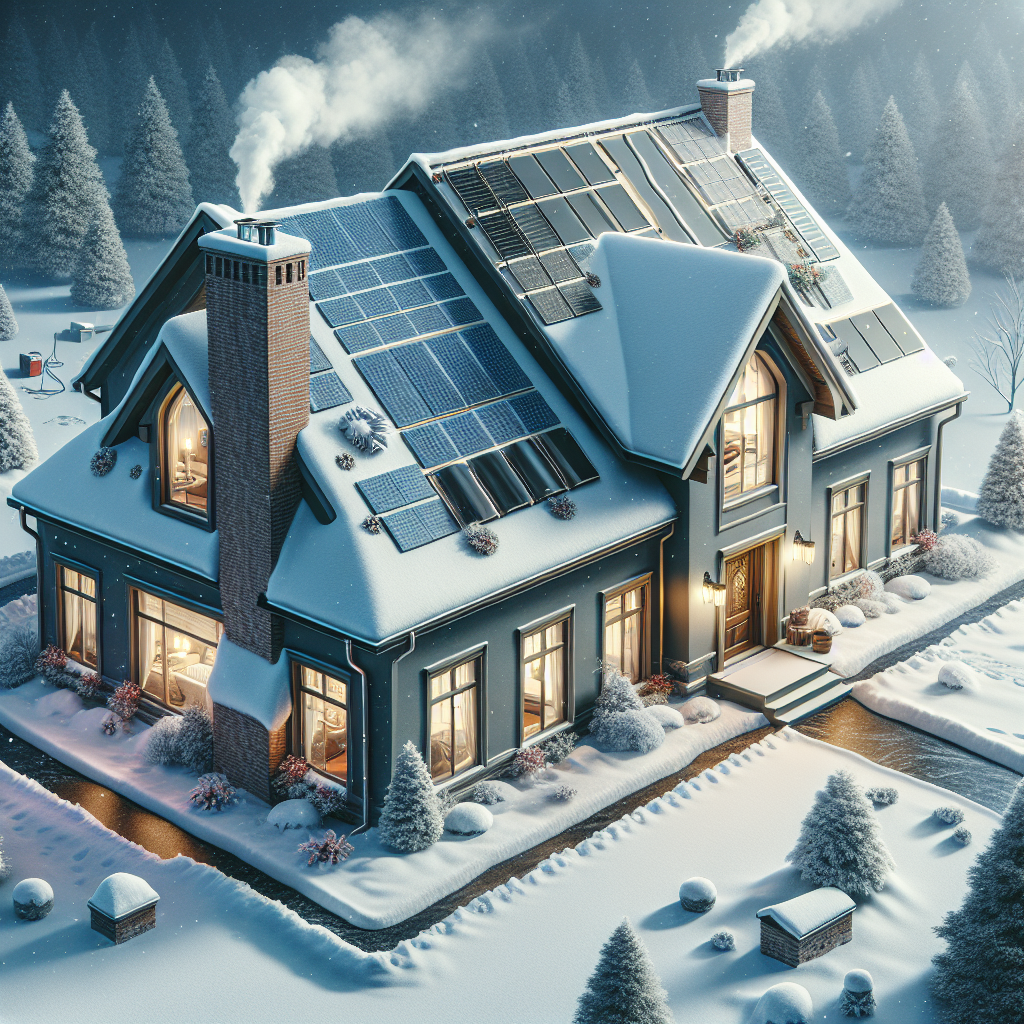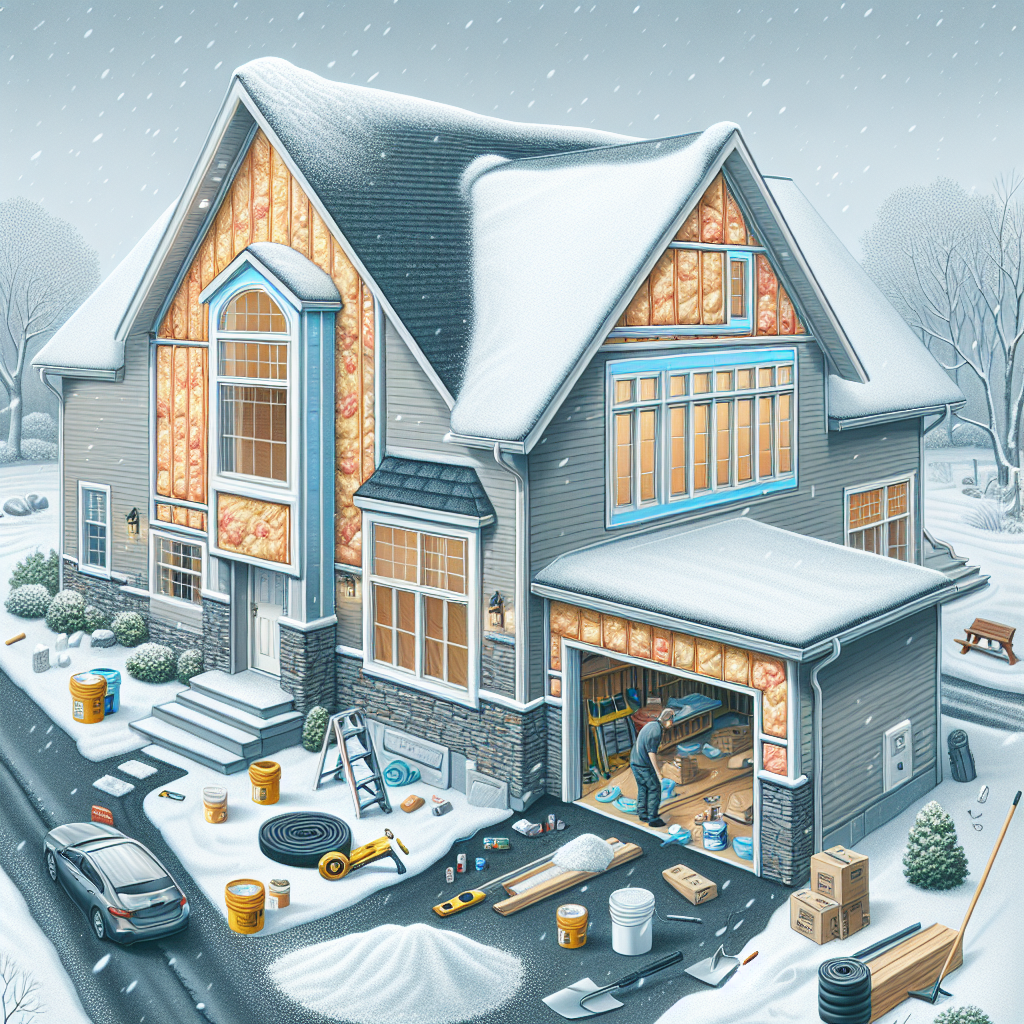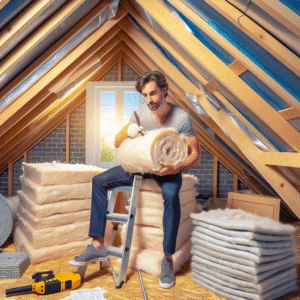As the chill sets in, it’s crucial for homeowners to turn their attention to winter weatherproofing. Not only does proper weatherproofing keep your home cozy and warm, but it also enhances energy efficiency, reducing those pesky heating bills. Whether you’re a seasoned DIY enthusiast or considering professional help, understanding the basics of home weatherproofing can significantly impact your comfort and wallet. In this guide, we’ll explore essential tips, top materials, and when to call in the experts for a snug, energy-efficient home this winter.
Essential Winter Weatherproofing Tips for Homeowners
Weatherproofing your home is an effective way to enhance comfort and achieve energy efficiency during the cold months. Here, we’ll delve into practical steps to ensure your living space remains warm without breaking the bank.
Inspecting and Maintaining Heating Systems
Start with a thorough inspection and maintenance of your heating system. Ensure filters are replaced or cleaned, and consider a professional check-up to keep your system running smoothly.
Insulating Windows and Doors
Check for drafts around windows and doors. Applying weather stripping or using thermal curtains can significantly cut down heat loss.
Checking for Drafts
Identify any gaps in the sealant around windows and doors. Simple caulking can address these leaks and greatly improve your home’s insulation.
Top 5 Weatherproofing Materials and How to Use Them
Choosing the right materials is pivotal for effective weatherproofing. Here’s a list of top materials that are both cost-effective and efficient.
- Spray Foam: Great for sealing gaps and adding insulation.
- Fiberglass: Commonly used in attics and walls for its insulative properties.
- Weather Stripping: Perfect for doors and windows to prevent air leaks.
- Caulking: Seals cracks and openings around window frames and doorways.
Each material serves a specific purpose and choosing the right one can lead to significant energy savings.
Professional Weatherproofing Services: When to Call in the Experts
Sometimes, the DIY approach might not suffice, especially when dealing with structural issues or when precision is crucial.
Structural Repairs and Energy Audits
If you encounter major structural concerns or want a detailed assessment, professional services like energy audits can pinpoint inefficiencies accurately.
Choosing a Reputable Contractor
Ensure the contractor is licensed, experienced, and comes with good recommendations. An expert can offer tailored solutions that DIY methods cannot achieve.

If you’re ready to take your home improvement or construction project to the next level, we can help! Find trusted contractors on BuildNet, whether you’re looking for renovations, new builds, electrical work, plumbing, or anything in between. Our directory connects you with qualified professionals who can make your vision a reality.
Essential Winter Weatherproofing Tips for Homeowners
As the leaves turn golden and the temperature starts to dip, it’s a clear signal that winter is on its way. For homeowners, this is the perfect time to think about weatherproofing your home. Not only does it ramp up your comfort during those chilly months, but it also boosts your home’s energy efficiency, saving you some hard-earned cash on heating bills. Let’s walk through some essential tips to get your home winter-ready!
Why Weatherproof Your Home?
First things first, let’s talk about why weatherproofing is so crucial. During winter, cold air can infiltrate your home, and warm air can escape, making your heating system work overtime. This not only leads to higher utility bills but could also shorten the life of your heating system due to the extra strain. By weatherproofing, you enhance your home’s insulation, keeping the warm air in and the cold air out, which translates to a cozier living space and lower energy consumption.
Inspecting and Maintaining Your Heating System
Before the winter fully sets in, it’s vital to give your heating system a thorough check-up. Here’s how to go about it:
- Professional Check-Up: Annually, hire a professional to inspect your furnace or heat pump. They can handle tasks that are more technical, like checking for carbon monoxide leaks or ensuring that the system is running at peak efficiency.
- Filter Replacement: Replace the filters of your heating system every few months or as recommended by the manufacturer. A clean filter improves airflow and efficiency, reducing wear and tear.
- Thermostat Calibration: Make sure your thermostat is working correctly and consider upgrading to a smart thermostat for better temperature control and energy savings.
Insulating Windows and Doors
Drafty windows and doors are notorious for letting heat escape. Here’s how to tackle them:
- Weather Stripping: Apply weather stripping around the movable components of windows and doors to seal off the gaps.
- Window Insulation Film: An affordable and effective way to insulate windows is to use transparent insulation film. It’s easy to apply and can significantly cut down on drafts.
- Draft Snakes: For a quick fix, use draft snakes along the bottom of doors to keep cold air from creeping in.
Checking for Drafts
If you’re feeling drafts in your home but can’t pinpoint where they’re coming from, here’s a simple method to locate those pesky air leaks:
- Visual Inspection: Check for gaps and cracks in places where different materials meet, such as between the foundation and walls or around windows and doors.
- The Incense Stick Test: Light an incense stick and hold it where you suspect a draft. The smoke will waver or be sucked out of or into the room, revealing the draft’s location.
- Professional Energy Audit: Consider a professional energy audit for a comprehensive assessment. This can pinpoint exactly where your home is losing energy and where you can save the most by weatherproofing.
Weatherproofing your home is a proactive approach to enhancing your comfort and ensuring your heating system works efficiently throughout the winter. By following these straightforward steps, you not only create a snug and warm living environment but also contribute to significant energy savings in the long run. Remember, the time and effort you invest now in weatherproofing your home will pay off manifold when the cold really sets in. Stay warm and safe!

Top 5 Weatherproofing Materials and How to Use Them
Hey there, savvy homeowner! As the chilly winds start knocking at our doors, it’s time to talk about keeping your lovely home cozy and efficient with some top-notch weatherproofing materials. Not only can proper weatherproofing keep the cold out and the warmth in, but it can also help you save a pretty penny on those heating bills. Let’s dive into the top 5 materials that you can use to seal the deal against the elements.
1. Spray Foam Insulation
What it is: Spray foam is a chemical product that expands and hardens upon application, creating a tight seal that can insulate and reduce air leakage.
How to use it: Spray foam is perfect for sealing gaps and cracks in your attic or crawl space. Simply clean the area to be treated, shake the can, and spray directly into the gaps. It expands to fill the space, so a little goes a long way!
Why it’s great: Apart from its excellent insulating properties, spray foam can significantly reduce noise from outside and prevent pests from entering your home. It’s a bit pricier upfront but is incredibly durable and effective in the long run.
2. Fiberglass Insulation
What it is: Comprising fine glass fibers, fiberglass is commonly used to insulate houses and comes in batts, rolls, or loose-fill.
How to use it: Fiberglass batts can be placed between studs in walls and joists in floors and ceilings. For the best results, wear protective clothing and ensure the spaces are completely filled without compressing the material, which can reduce its effectiveness.
Why it’s great: Fiberglass is relatively inexpensive and has a high R-value, meaning it’s very effective at resisting heat flow. It’s also moisture resistant, which helps in preventing mold growth in your home.
3. Weather Stripping
What it is: Weather stripping involves applying a strip of material around windows and doors to seal gaps that allow air leaks.
How to use it: Choose from materials like felt, foam, or vinyl and simply cut to size and adhere to the frame where the window or door closes. For doors, make sure to apply at the bottom as well, using a door sweep.
Why it’s great: It’s an inexpensive and simple DIY solution that can be done in an afternoon. Weather stripping also helps to keep dust and pollen out, which is a boon for allergy sufferers!
4. Caulking
What it is: Caulk is a flexible, waterproof adhesive used to seal joints or seams against leakage in various structures and piping.
How to use it: Use caulk to fill in gaps or cracks around window frames, door frames, and baseboards. Clean the area thoroughly, apply the caulk, and smooth it out with a wet finger or tool to ensure it adheres well.
Why it’s great: Caulking not only prevents drafts but also water damage and insect intrusion. It’s a quick fix that can improve the energy efficiency of your home significantly.
5. Window Insulation Film
What it is: This is a plastic film applied to the interior of window panes to reduce heat transfer, thus keeping your home warmer in winter and cooler in summer.
How to use it: Kits are available that include everything you need. After cleaning the window glass, apply the double-sided tape, attach the film, and then use a hairdryer to shrink the film and remove wrinkles.
Why it’s great: Window insulation film is a cost-effective method to enhance the thermal efficiency of old windows. It’s almost invisible and can be easily removed when warmer weather arrives.
With these materials in your arsenal, you’re well on your way to a snugger, more energy-efficient home. Remember, taking the time to properly weatherproof your home not only boosts comfort but also contributes to lowering those seasonal energy costs. Grab your tools and let’s make your home ready to tackle whatever weather comes your way!
Professional Weatherproofing Services: When to Call in the Experts
So, you’ve tried your hand at DIY weatherproofing around your home, and while it’s been a beneficial endeavor, there are just some tasks that scream for a professional touch! Whether it’s the complexity of the job or the tools required, some weatherproofing measures need the expert hands of a seasoned professional. Let’s dive into why and when you should consider calling in the experts for weatherproofing your home.
Recognizing the Need for Professional Help
It’s important to know your limits when it comes to home improvement projects. Complex issues like structural repairs or comprehensive energy audits are not only challenging but can also be unsafe if not handled correctly. Here are a few scenarios where you might need to step back and dial in the pros:
- Structural Concerns: If you notice significant issues like foundation cracks or major leaks, these are indicators of potential structural failures. Handling these issues might require professional intervention to ensure that the weatherproofing work is effective and enduring.
- Lack of Proper Tools: Some weatherproofing tasks might require specialized tools that are not typically found in a DIY toolkit. Professional weatherproofers come equipped with the right tools and technology to perform the job efficiently and safely.
- Ensuring Energy Efficiency: Professionals can conduct detailed energy audits to pinpoint exact spots where air leakage occurs. This process involves infrared cameras and other advanced technology that most homeowners don’t have access to.
Services Offered by Weatherproofing Professionals
Knowing what professionals can offer is crucial in understanding their value. Here’s a look at some of the services that weatherproofing experts provide:
- Comprehensive Energy Audits: This service helps identify the key areas where your home is losing energy. By understanding these weak spots, professionals can better target their weatherproofing efforts, making your home more energy-efficient.
- Advanced Insulation Installation: Professionals can install various types of insulation, such as spray foam or blown-in insulation, which might be difficult for a DIYer to handle correctly.
- Custom Weather Stripping and Caulking: Expert installers can ensure that all cracks and gaps are sealed, preventing air leaks that could lead to higher energy bills.
Choosing the Right Weatherproofing Professional
Selecting the right contractor can make all the difference in your home’s weatherproofing project. Here are a few tips to help you pick a reputable and effective professional:
- Look for Experience and Specialization: Choose a contractor who specializes in weatherproofing and has a solid track record. Experienced professionals understand the nuances of the job and can provide insights and solutions that are not readily apparent to less specialized contractors.
- Check Reviews and References: Don’t just take their word for it; look for reviews and ask for references. A reputable contractor will be happy to share the experiences of past clients.
- Verify Licenses and Insurance: Ensure that the contractor is licensed to perform weatherproofing work in your area and carries adequate insurance. This protects you against any potential damages or accidents that could occur during the project.
What to Expect From a Weatherproofing Service
Once you’ve selected a professional, knowing what to expect can help you prepare for the process. Here’s what typically happens:
- Initial Assessment: The professional will conduct a thorough examination of your home to identify areas that need attention. This might include checking for drafts, inspecting insulation, and evaluating the exterior of the house for any potential issues.
- Detailed Plan: Based on the assessment, the contractor will provide a detailed plan of what needs to be done, along with the expected costs and timeline for the project.
- Execution: The actual weatherproofing work can vary in duration depending on the scale of the project. It might involve installing new insulation, applying sealants, and upgrading windows and doors to more energy-efficient models.
- Final Walk-through: After the work is completed, a good contractor will do a final walk-through with you to ensure that all the agreed tasks have been completed to your satisfaction.
Calling in professionals might seem like a big step, but when it comes to ensuring your home is properly weatherproofed, it’s a worthwhile investment. Not only does it save you time and potential hassle, but it also ensures that the job is done right—the first time. So, if you’re facing a daunting weatherproofing project, don’t hesitate to reach out to the experts. Your home (and your wallet) will thank you!

Why is weatherproofing my home important?
Weatherproofing your home is crucial for several reasons. Primarily, it enhances energy efficiency by keeping cold air out and warm air in, which reduces the workload on your heating system and lowers your energy bills. Moreover, it increases comfort during the cold months by eliminating drafts and maintaining a consistent indoor temperature. Effective weatherproofing also protects the structural integrity of your home by preventing moisture from entering and causing damage.
What are the first steps to weatherproof my home for winter?
Begin by inspecting your heating system to ensure it’s functioning efficiently. Check and replace filters, and consider a professional tune-up to address any potential issues. Next, assess areas around windows and doors for drafts. Use weather stripping or caulking to seal any gaps, and consider using thermal curtains or plastic window seals for additional insulation. Don’t forget to check your attic and basement, as these areas are common sites for heat loss.
What are the best materials for insulating my home?
Several effective materials can be used for insulation:
- Spray Foam: Excellent for sealing gaps and cracks, spray foam expands to fill spaces, providing a high level of insulation.
- Fiberglass: Commonly used in batts, it’s suitable for walls and attics and offers good thermal and sound insulation.
- Weather Stripping: Ideal for doors and windows to prevent drafts.
- Caulking: Used to seal joints and seams against leaks and drafts in stationary structures like window frames.
Each material varies in cost, effectiveness, and longevity, so choose based on your specific needs and budget.
How do I apply caulking and weather stripping?
To apply caulking, clean the area thoroughly and apply the caulk to any gaps or cracks, smoothing it with a caulking tool or your finger (wearing a glove). For weather stripping, measure the area around doors and windows, cut the stripping to size, and secure it in place, ensuring a tight fit to prevent any air leaks.
When should I consider hiring a professional for weatherproofing?
Consider hiring a professional if your home requires structural repairs or if you have areas that are difficult to insulate or seal properly. Professionals can also perform energy audits to identify less obvious areas of energy loss and provide advanced solutions like blown-in insulation or thermal imaging.
How do I choose a reputable weatherproofing contractor?
Look for contractors with good reviews and proper licenses. Ask for references and examples of their previous work. Ensure they provide a detailed quote and explain the scope of their services. A reputable contractor will be transparent about costs and the expected outcomes of their work.
Conclusion
Weatherproofing your home is an essential task that not only enhances comfort but also contributes to significant energy savings. From simple DIY sealing techniques to professional upgrades, there are numerous ways to protect your home from the harsh winter elements. Remember, proper maintenance and timely upgrades can prevent costly repairs in the future.
If you feel overwhelmed or unsure about tackling this project on your own, it’s a good idea to contact a professional. At BuildNet, we connect you with local, skilled contractors who can provide a free quote and expert advice tailored to your specific needs. Whether it’s installing advanced insulation solutions or conducting detailed energy audits, our professionals are here to help ensure your home is perfectly prepped for winter. Don’t hesitate to get in touch through our website to find out more about how we can assist you in making your home warm, cozy, and energy-efficient this season!







